Book Review: Quiet New York
“Let silence take you to the core of life.”
This quote by the 13th-century Persian mystic Rumi could serve as the unofficial motto for author Siobhan Wall and her series of unusual travel guides. She is an artist, photographer, writer, and curator in search of tranquility, even in the very midst of urban life.
Motivated partly by her personal preference for a slower and quieter way of life, partly by an illness that caused some loss of hearing, this quest for silence has inspired four eclectic travel books so far.
After Quiet Amsterdam, Quiet London, and Quiet Paris, the latest volume, Quiet New York, is just fresh off the presses. It is a guide to a selection of peaceful places in the biggest US metropolis, oases of calm right in the City That Never Sleeps.
 The vivid evocation of NYC’s soundtrack in the book’s introduction makes this sound like a rather elusive goal: New York is full of noises, from the early-morning clanging of the garbage trucks, over the constant honking of angry cab drivers, to the throbbing beats of party music from the city’s nightclubs. There are even some construction sites that are busy 24/7, at noon as well as midnight!
The vivid evocation of NYC’s soundtrack in the book’s introduction makes this sound like a rather elusive goal: New York is full of noises, from the early-morning clanging of the garbage trucks, over the constant honking of angry cab drivers, to the throbbing beats of party music from the city’s nightclubs. There are even some construction sites that are busy 24/7, at noon as well as midnight!
However, in the course of her seven-week research, the author did assemble an astounding variety of silent spots in all five boroughs of New York City, free of traffic noise and background music. Many of them are word-of-mouth recommendations by friendly locals.
The over 150 portraits all provide brief descriptions of the location, an illustrative photograph taken by the author herself, as well as practical information for visitors. Both tourists and residents who are new in town may now take a laidback, blessedly noise-free tour round the featured places from one of the following categories:
• Parks and gardens 
• Museums and art galleries
• Cafés and restaurants
• Places to relax
• Shops and bookstores
• Places near water
• Libraries and cultural centers
• Places of worship
• Places to stay

• Museums and art galleries
• Cafés and restaurants
• Places to relax
• Shops and bookstores
• Places near water
• Libraries and cultural centers
• Places of worship
• Places to stay
Some are fairly well-known locations that even I have heard about. (Unfortunately, I’ve never been to NYC, though it’s definitely on my list of places to see before I die.) These include, for example, Central Park, the inter-faith chapel at the United Nations, or Katz’s Deli of When Harry met Sallyfame.
On the other hand, there are also plenty of unassuming nooks and crannies off the beaten track: for instance, several community gardens created by local activists and lovingly maintained by neighborhood residents, or an old-fashioned millinery shop for hand-crafted headgear.
The selection of quiet places also reflects New York’s history and diversity: In the museums, you can explore, among other things, the city’s colonial era, 19th-century immigrant life on the Lower East Side, or contemporary gay and lesbian art.
Cultural centers are dedicated to the resident Korean, Japanese, and African-American communities, and St Peter’s Catholic Church is introduced alongside the beautiful Central Synagogue and a Quaker meeting house.
Obviously, you can sample diverse cuisines in New York City, too. In the proposed eateries, you can enjoy Chinese dumplings, organic food, or traditional Italian dishes in peace and quiet.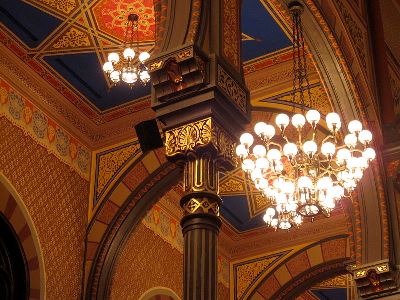

If you are on a shoestring budget, you may be interested in free institutions such as public libraries and parks, but there’s something for the well-heeled as well: You can relax at an upscale spa or sleep in a luxury apartment suite with its own Zen garden.
For me, the concept ofQuiet New York holds great personal appeal: I rather like exploring cosmopolitan cities, but I’m also a bit of an introvert who gets stressed out by too many crowds and too much noise. Travel guides like this one could be a nice solution for this dilemma. If or when I finally make my dream of going to NYC come true,Quiet New York could be a useful source of information and inspiration.
For example, I’d dearly like to see The Cloisters, a museum of medieval art designed in the style of a French monastery and situated in Fort Tyron Park, above the Hudson River. The author’s own favorite spot sounds like a great place for a picnic in spring: In Brooklyn Botanic Garden, you can admire the cherry blossom esplanade in April, or dine in a bluebell wood in May.
Perhaps this book will inspire you as well!
What are *your* favorite peaceful places round the globe?
PS: If you are an expat living in New York, feel free to come to a book signing at Word Brooklyn (126 Franklin St) on Sunday, April 6, at 4 pm.
Special thanks to Siobhan for the review copy of her book!
(Photo credit: 1) Japanese Pond in Brooklyn Botanic Garden, public domain 2) Red Coat / Red Stairs(Roosevelt Island, NYC, at Dusk) by Ludovic Bertron 3) Central Synagogue, NYC, public domain)
Make Your Choice: Voting Rights for Expats
Today, we’re exploring the issue of voting rights for expats, especially within the EU. Find more information on absentee voting below!
Outside the InterNations office in Munich, the cityscape is still cluttered with slightly faded posters for the most recent electoral campaign. About two weeks ago, eligible residents were invited to go to the polls and vote for the new city council. On Sunday, another run-off ballot will decide who is going to be Munich’s next mayor.
Voting Locally
For some members of the expat community in town, local elections may have a special status. Since 1992, expatriate EU nationals have been allowed to cast their vote or stand for candidate in their current country of residence, provided they live in another EU member state.
Some countries in the European Union also permit non-EU resident to participate in local elections. This is, for example, the case in Ireland, the Netherlands, Denmark, and Sweden.
 Compared to the huge media response that usually accompanies national campaigns, voting on a local level seems somehow less exciting. However, decisions made in local politics often affect our day-to-day lives more than we might think.
Compared to the huge media response that usually accompanies national campaigns, voting on a local level seems somehow less exciting. However, decisions made in local politics often affect our day-to-day lives more than we might think.
In Munich, for instance, the municipal government is involved in issues as diverse as disposing of our household waste, maintaining the public transport network, running daycare centers for toddlers, or sponsoring cultural events.
Therefore, it’s a bit surprising that comparatively few EU citizens make use of their right to the local vote. About 8 million people living in other EU member states are eligible to vote, but only 10% of them go to the polls in municipal elections across various various member states.
Voting for the European Parliament
Voting for a new mayor or your town councilor of choice isn’t the only political decision that European expats may be entitled to. As soon as Munich’s posters for the mayoral elections are taken down, I suspect that others will soon appear in their place. After all, the EU-wide elections for the members of the European Parliament are scheduled for May 22, 2014.
Again, EU nationals can vote in any other member state where they reside. In this case, the voter turnout tends to be a lot higher. It normally ranges from 45% to over 90%, depending on the individual country.
And yet again, we shouldn’t underestimate the potential impact of our decisions. The European Parliament can debate and pass laws applied from the Polar Circle to the Mediterranean, from the Atlantic to the Black Sea. The institution is also responsible, together with the European Council, for discussing and adopting the EU budget.

If you’d like to read up on the impending European elections, please check outEuropean Citizens Abroad. The non-partisan NPO wants to raise awareness of EU issues, increase the voter turnout among EU expatriates, and help to standardize some aspects of voting legislation within the EU.
For example: nationals of some EU member states can participate in EU elections even while they live outside the EU, whereas other can’t. If you do decide to go the polls, the site’s voter registration deadlines for various EU countries are of interest as well.
Voting in National Elections
Last but not least: what about expats in general, EU nationals or not, and absentee voting in national elections? If you live abroad and still want to have some say in national politics back home, it’s best to get informed as early as possible.
Get in touch with your nearest embassy or consulate and ask them for further details on the absentee ballot. Often, there is some sort of application process to complete and that may take a while.
So, no matter where you are from and where you live now, find out in which elections you are able to vote and how to go about it. Regardless of whether or not you ultimately decide to participate, at least you can make an informed decision.
(Image credit: 1) Vote icon: public domain 2) Flag of the European Union by flickr user rockcohen)
Founder’s Diary: Farewell in Madrid
Time to say goodbye… InterNations founder and CEO Malte Zeeck talks about the special occasion that motivated his latest trip to our Local Community in Madrid.
In early March, I was back in Madrid after quite a while. The reason for my visit was a rather sad one, though: not only was I planning to attend an InterNations Event (obviously not the sad part), but I also had to say goodbye to our long-time Ambassador in the Spanish capital, Catharina.
Way back in March 2008, about half a year after InterNations went online, I organized the very first Madrid Event myself. We were still looking for the perfect InterNations Ambassador to look after our budding expat community.
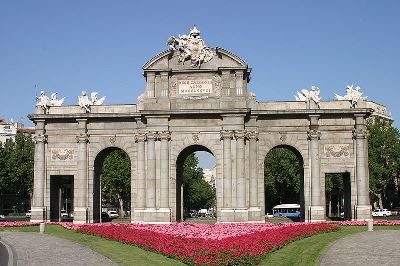 At that time, the Local Community in Madrid counted barely 500 members. Nonetheless, as many as 70 guests came to the first get-together in a bar near the Puerta de Alcalá, right in the city center.
At that time, the Local Community in Madrid counted barely 500 members. Nonetheless, as many as 70 guests came to the first get-together in a bar near the Puerta de Alcalá, right in the city center.
That’s where I met Catharina, a German expat from Hamburg, who’d heard from her friend Daniela (then the InterNations Ambassador in Barcelona) about our network. So we immediately found some common ground, deciding to develop InterNations in Spain together.
Catharina had moved to Madrid only recently in order to join her boyfriend, who was running his own business there. She knew what being new in town felt like. Ever since spring 2008, she’s been our Ambassador in the Spanish capital and organized regular events for the international and global-minded community.
These days, there’s actually an InterNations Event in Madrid every week. They take place in the city’s most popular venues, in exclusive locations like the rooftop terrace of the ME Hotel, the Real Café Bernabéu, or the Fortuny nightclub. No wonder that these gatherings attract up to 500 members from all over the world!
By now, the Local Community in Madrid has grown to an impressive size of nearly 20,000 people. InterNations has clearly become the place to be for expats living in the heart of Spain.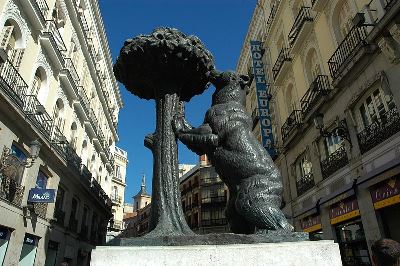

During those six years, Catharina has had a lot of support: from her Co-Ambassadors, her assistants, and, of course, from her boyfriend. They got married and now have two kids, and she still managed to host the best events in town.
Therefore, it was with a rather melancholic feeling that I traveled to Madrid for Catharina’s farewell party. For the InterNations Event, she’d reserved the Callejón de Serrano, a stylish club on one of Madrid’s poshest shopping streets.
Over 300 people, regulars and relative newcomers alike, were there to bid their Ambassador farewell. Everyone told me what a great job Catharina had been doing and how much they’d miss her, now that she was going to return to Hamburg with her family.
I’d bought one of the biggest bouquets available at a local flower shop, as a little “thank you” gesture for everything that Catharina had done for our community. Handing her the flowers turned out to be a very touching good-bye – it was clearly a highly emotional moment for Catharina. She received an enthusiastic applause from the guests, and afterwards, they were lining up to say their goodbyes in person.
A few members also expressed their interest in the Ambassador position. For obvious reasons, we are now searching for new InterNations Ambassadors to follow in Catharina’s footsteps. One thing is certain: they’ll have a big pair of shoes to fill!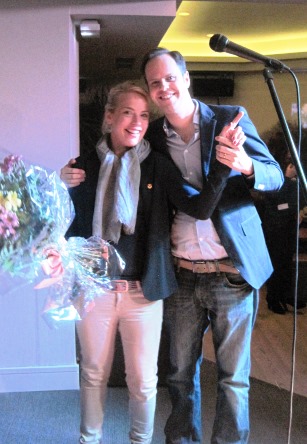

After the event on Thursday night, I got to stay in Madrid for a few more days. Thus I had the chance to invite Catharina and her husband to La Mucca, one of the best tapas places in the city. (The next time you are in Madrid, just give it a try.)
We dined out together on the first really beautiful weekend in spring, and Madrid was appearing at its best. Due to the mild weather, the residents flocked to the streets, enjoying the sunshine during the day and the buzz of the nightlife later on. There was very little that pointed at the severe economic and financial crisis that Spain is going through at the moment.
After such a lovely weekend, I’m sure I’ll find the opportunity to return to Madrid soon enough. We have big plans for our InterNations Community there, but I can’t reveal them quite yet. More on this topic is to follow – we’ll keep you updated!
(Image credit: 1) Puerta de Alcalá, Madrid by flickr user jpvargas 2) The Bear and the Arbutus Tree, Madrid by fickr user Pazit Polak 3) Malte Zeeck/InterNations)
Got Spring Fever?
Have you ever heard of “spring fever”? (No, it’s not the same as hay fever.) Today, we’re talking about the difference betwen “spring fever” and its negative side, “spring tiredness”. Read on for some helpful tips on how to stay active and healthy in spring.
Finally! In the past week, spring has arrived here in Munich. Last weekend, sunshine and blue skies lured the locals out of their cozy apartments: everyone switched off their central heating, flung the windows open, and then took to the streets.
Beergardens, open-air cafés, and ice-cream parlors were packed as though they were all to be closed tomorrow. Munich is firmly in the thrall of “spring fever”.
“Spring Fever” vs. “Spring Tiredness”
In English, you talk of said “spring fever” to refer to the sudden increase in energy, vitality, and even libido that many people feel once the cold season’s over at last. In German, however, there’s a different expression.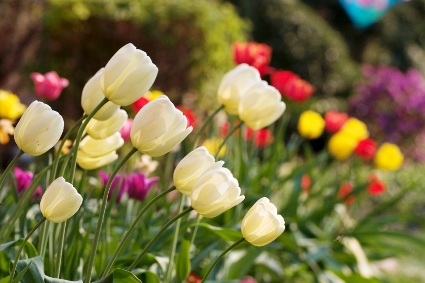

Frühjahrsmüdigkeitliterally means ‘spring tiredness’. Indeed, more than a few folks go through an annual bout of Frühjahrs- müdigkeit before they eventually enjoy the beneficial effects of spring fever.
In regions particularly affected by seasonal changes, for example large parts of Europe and North America, spring tiredness is a fairly common phenomenon. The closer you live to the equator, the less impact it has. In the sub-tropics and tropics, it shouldn’t be an issue at all.
It’s Those Pesky Hormones!
Spring tiredness usually rolls around in March or April – in the Northern Hemisphere, that is – and last for several days, if you’re lucky, and for up to one month, if you’re not. Typical symptoms include sleepiness, exhaustion, dizziness, headaches, and mood swings.
It’s not an actual disease, but it can be really irritating. Why do so many of us have to put up with those annoying ailments when we’d rather bask in the sunny weather?
Well, we just can’t deny our animal nature. Us human beings don’t hibernate and then wake up again like so many other mammals, but we do get a slight “hangover” after the long, cold darkness of the winter months. Once daylight hours lengthen and temperatures rise, our body reacts to these changes.
 The brain starts curbing the production of melatonin (the hormone that regulates our sleep-wake cycle) and begins to ramp up serotonin and endorphins instead. These substances are responsible for many bodily functions (such as feeling pain or hunger), but they are widely known as “happiness hormones” for a reason. However, until our hormonal levels are perfectly balanced, our body gets a bit confused, simply speaking.
The brain starts curbing the production of melatonin (the hormone that regulates our sleep-wake cycle) and begins to ramp up serotonin and endorphins instead. These substances are responsible for many bodily functions (such as feeling pain or hunger), but they are widely known as “happiness hormones” for a reason. However, until our hormonal levels are perfectly balanced, our body gets a bit confused, simply speaking.
Moreover, warmer temperatures widen our blood vessels. which makes the blood circulate more freely through our veins, but which also causes our blood pressure to drop. If you have low blood pressure to begin with, this will contribute even further to your general lack of energy and moodiness.
How to Keep Active and Healthy
In short, we suffer from a kind of seasonal “mini-jetlag” until we’ve adjusted to the new environment. Fortunately, there are plenty of things you can do to feel fit and healthy again!
• Natural light and fresh air are the two easiest remedies. Venture outdoors for a brisk walk as often as possible – even if it’s cloudy and cool outside.
• If you are a sporty kind of person, this is the perfect opportunity to indulge in some exercise. Endurance sports such as swimming, running, hiking, Nordic walking, or cycling are particularly recommended.
 • Even if you are very tired, try to adopt a regular sleep schedule that follows the sun, more or less: early to bed and early to rise, and perhaps a short power nap after lunch. (Emphasis on short!)
• Even if you are very tired, try to adopt a regular sleep schedule that follows the sun, more or less: early to bed and early to rise, and perhaps a short power nap after lunch. (Emphasis on short!)
• Alternating hot and cold showers will also raise your energy levels. If you aren’t brave enough to begin your day like this, the occasional visit to the sauna will do the trick just as well.
What (Not) to Eat
Vitamins and proteins are good for you, too. In winter, we tend to eat rich and heavy foods: this is another reminder of our mammalian forebears, who needed protective layers of fat during times of scarcity. Furthermore, before greenhouses and freezers were invented, fresh produce was often hard to come by after harvest time.
In spring, you should switch to plenty of fresh fruit and veggies, as well as lighter dishes, for instance fish, grilled chicken, or tofu. Don’t forget to drink lots of mineral water and herbal tea as well, and lay off the alcohol and hot chocolate for a while.
Of course, you shouldn’t overdo the self-chastisement. You still want to enjoy the spring fever, don’t you?
Just go outside, take a long walk, and sit down in a nice café afterwards. Maybe you could switch the ice-cream sundae for a fruit salad, but you can still soak in the sunshine regardless.
What are you doing to keep fit and healthy in spring?
(Image credit: iStockphoto.com)
Filed under: Expat Advice on March 13th, 2014 | No Comments »
False Economy? The EIU Cost of Living Index 2014
In last week’s blog post, we introduced the best (and worst) cities for expat life in 2014. Thus, it’s only fitting that we’re taking a closer look at the worldwide cost of living today. We are examining the results of the latest EIU Cost of Living Study and how helpful they are for individual expats.
If you want to indulge in luxury, pack your belongings and move to Singapore. At least, that’s what theEconomist Intelligence Unit claims. According to their latest cost of living index, the Southeast Asian city state is the priciest expat hotspot on the globe.
 Every year for the past three decades, the EIU has published a yearly survey, ranking up to 140 international cities in 93 countries, based on what expat executives need to pay in order to maintain their lifestyle.
Every year for the past three decades, the EIU has published a yearly survey, ranking up to 140 international cities in 93 countries, based on what expat executives need to pay in order to maintain their lifestyle.
In the 2014 study, the top ten costliest destinations are as follows:
• Singapore (Singapore)
• Paris (France)
• Oslo (Norway)
• Zurich (Switzerland)
• Sydney (Australia)
• Geneva (Switzerland)
• Caracas (Venezuela)
• Melbourne (Australia)
• Tokyo (Japan)
• Copenhagen (Denmark)
• Paris (France)
• Oslo (Norway)
• Zurich (Switzerland)
• Sydney (Australia)
• Geneva (Switzerland)
• Caracas (Venezuela)
• Melbourne (Australia)
• Tokyo (Japan)
• Copenhagen (Denmark)
In Singapore, this list has caused quite a stir among the concerned public: it fits neatly into ongoing debates about rising living expenses and the resulting worries among the local population. After all, Singapore is often called “the Switzerland of Asia” for a reason.
It’s hardly surprising, either, that two cities in actual Switzerland have made the list, or that Norway and Japan make an appearance: all these countries are known for forcing residents to dig deep into their pockets.
In some other ways, however, the ranking seems a bit counter-intuitive. What on Earth makes the Venezuelan capital such an unaffordable place?
Once you move a little further down the list, the bafflement continues: 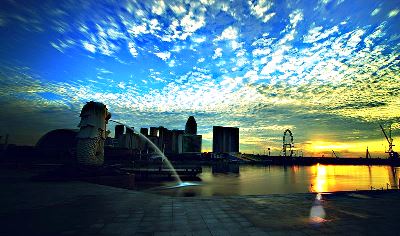 Is Frankfurt (Germany) on #11 so much more expensive than both London and NYC? Is Mumbai in India on the very last rank (#131) really the cheapest metropolis ever?
Is Frankfurt (Germany) on #11 so much more expensive than both London and NYC? Is Mumbai in India on the very last rank (#131) really the cheapest metropolis ever?
 Is Frankfurt (Germany) on #11 so much more expensive than both London and NYC? Is Mumbai in India on the very last rank (#131) really the cheapest metropolis ever?
Is Frankfurt (Germany) on #11 so much more expensive than both London and NYC? Is Mumbai in India on the very last rank (#131) really the cheapest metropolis ever?
If we review thesurvey methodology, we might clear up some of the confusion. The EIU researchers have compared about 400 prices for 160 products or services across a dozen different categories, from groceries over utilities and rental costs to leisure activities.
Each price is converted into USD, and then the items are weighted according to a unified pattern. For the final ranking, the price of staple foods, for example, is of much greater importance than, say, the expenses for concert tickets.
However, as just mentioned, the weighting scale for the items is indeed the same everywhere. This, in turn, assumes that spending patterns remain the same around the globe.
One of the survey’s original purposes is to help companies decide upon the cost-of-living allowances for their foreign assignees. Expats on international assignments – thus the argument – should have the financial means to live in the same manner, with the same kinds of goods, as they would back home.
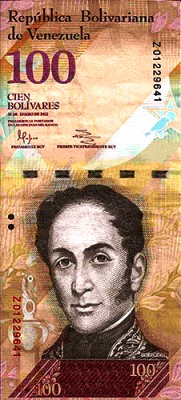 Obviously, this reasoning doesn’t account for the different lifestyles among local residents, nor does it take into consideration that expatriates, too, often adjust their way of life to various circumstances.
Obviously, this reasoning doesn’t account for the different lifestyles among local residents, nor does it take into consideration that expatriates, too, often adjust their way of life to various circumstances.
One of the reasons cited for Singapore’s #1 ranking are the extremely high transport costs, due to the prohibitive expenses associated with owning a car. Now it’s true that ownership of a vehicle is a downright extravagance in Singapore. But in a fairly diminutive state with a well-developed public transport network, plenty of expats will think twice about their need for speed and switch to the MRT railway system instead.
What is more, the fact that all prices are converted to US dollars and compared to New York City as a base poses another fundamental problem. For instance, the Venezuelan bolívar is officially pegged to US currency: 1 US dollar is worth 6.3 VEB. Emphasis on “officially”.
As the country has been suffering from high inflation for years, the reality looks rather different. On the black market, you’ll get far more favorable exchange rates for your dollar, which means that Caracas should be a lot further down the list.
Of course, Venezuela – a country plagued by currency depreciation and violent unrest – is an extreme example. Still, the conversion to US dollars means that fluctuating exchange rates can cause changes in rank just as much as actual price increases or reductions do.
If you’re worried about your actual expenses after an impending move, rankings such as the EIU one aren’t actually false, but they can be misleading. Above all, they don’t replace the need some for in-depth research according to your personal situation!
(Image credit: 1) iStockphoto.com 2) Sunrise, Marina Bay, Singapore by Mohd Kamal 3) 100 Bolívar Banknote by Cleiberlopez)
The Best (and Worst) Cities for Expat Living
InterNations takes a closer look at the highest-ranking — and lowest-ranking — international destinations in the Mercer Quality of Living Survey 2014.
What kind of qualities should you bring to the table so you can enjoy expat life in the most livable cities worldwide? It might come in handy to have some German language skills – or to really love hobbits. Being a fan of ice hockey might also do in a pinch. Just kidding!
However, the expatriate hotspots with the (allegedly) highest quality of life around the globe are indeed clustered in a number of specific countries, i.e. Austria, Germany, and Switzerland, as well as New Zealand and Canada.
 Every year, Mercer, a global HR consulting firm, conducts both a big cost of living and an in-depth quality of life survey. The data for the latter were collected last November, and the results were published only recently for the Mercer City Ranking 2014.
Every year, Mercer, a global HR consulting firm, conducts both a big cost of living and an in-depth quality of life survey. The data for the latter were collected last November, and the results were published only recently for the Mercer City Ranking 2014.
The Mercer team gathers detailed information on nearly 40 factors from 10 different categories that all influence the quality of living in a particular place. These factors can be political and social (e.g. safety and crime), economic, socio-cultural (e.g. degree of personal freedom), or medical (e.g. healthcare, health risks). Moreover, they assess local infrastructure, education, opportunities for leisure activities, housing, availability of consumer goods, and the natural environment (e.g. climate, special hazards).
All these variables determine the overall “livability” of a city for foreign assignees, expat executives, and their families. Depending on such rankings, personnel sent on certain assignments may or may not get a so-called “hardship allowance” as part of their relocation package. But for moving to the top destinations, no such financial incentive seems to be necessary.
The five highest-ranking cities in the current Mercer table include:
• Vienna (Austria)
• Zurich ( Switzerland)
Switzerland)
• Auckland (New Zealand)
• Munich (Germany)
• Vancouver (Canada)
• Zurich (
 Switzerland)
Switzerland)• Auckland (New Zealand)
• Munich (Germany)
• Vancouver (Canada)
Other cities from the same countries make up nearly all of the first 15 to 25 places in the league table: Swiss metropolises Geneva and Bern are to be found on rank 8 and 13, respectively; Düsseldorf (#6) and Frankfurt (#7) aren’t far below Munich, while Berlin and Hamburg still show up among Mercer’s top twenty.
Canada is further represented with Ottawa (#14), Toronto (#15), and Montreal (#23) – all of which are soundly beaten by Kiwi capital Wellington (#12).
The European cities in particular received glowing recommendations for their general stability and safety, infrastructure and healthcare services, as well as recreational facilities. In addition, Canada and New Zealand both have breathtaking natural beauty to offer. Of course, in Munich, Vienna, and Zurich the awe-inspiring scenery of the Alps is less than a day’s journey away.
On the other end of the scale, the lowest rankings go – rather unsurprisingly – to places greatly affected by poverty, natural disasters, social unrest, and war.
Brazzaville (Republic of Congo) was the theatre of a bloody civil war in the late 1990s, and the local infrastructure still hasn’t recovered from its aftermath. Sana’a, the Yemeni capital, regularly appears as a “no-go area” in travel warnings, due to the high risk of terrorist incidents and targeted kidnappings.
Brazzaville (Republic of Congo) was the theatre of a bloody civil war in the late 1990s, and the local infrastructure still hasn’t recovered from its aftermath. Sana’a, the Yemeni capital, regularly appears as a “no-go area” in travel warnings, due to the high risk of terrorist incidents and targeted kidnappings.
N’Djamena (Chad) is unfortunately (in)famous for being one of the poorest and most corrupt cities in the world, and Bangui (Central African Republic) is plagued by similar problems. After a putsch in the CAR about one year ago, the political situation remains unstable, and the city’s infrastructure is more or less non-existent. Even in the capital, a lack of water, electricity, and phone connections are often the norm.
On the last rank of all 223 Mercer cities, there’s Baghdad (Iraq) – still one of the most dangerous cities in the world, where only the International Zone provides a certain measure of safety for the foreign community. It’s a long way from drinking coffee in a Viennese café along the River Danube to the River Tigris, where armed guards are part of many people’s daily routine…
(Photo credit: 1) Michaelerplatz, Vienna by Marek Ślusarczyk 2) Town Hall, Zürich by Roland Zh 3)Devonport, Auckland by Ronnie Macdonald)
Filed under: Adventures Abroad, Moving to Another Country, Polls & Surveys on February 27th, 2014 | No Comments »
Things to Consider Before Taking an International Assignment
Since the new year 2014 is barely two months old, many of us are still considering new beginnings. If your new beginning involves working abroad as an expat woman, this is exciting news and you are in good company.
There is a projected boom in the number of expats over the next few years, due to organizations recognizing the value of developing leaders who intimately understand business at an international level. As you consider the option to work and live abroad, we would like to share some advice from women who have already taken the leap.

Here are some thoughts that WiSER (Women in Senior-level Expatriate Roles) have shared with us on things to consider before accepting an expatriate assignment.
Think it through: Think deeply about the implications of moving to a wholly new environment.
Find an assignment that is a good cultural fit for you and your family: It is essential to do your homework in order to truly understand the market and other relevant variables, including safety, living conditions, schools, proximity to daily activities, and so forth.
Find a female-friendly employer: If you are considering an employer who provides international opportunities, it is also important to determine whether it has a corporate culture where female employees are encouraged to identify their goals and then helped to achieve them.
Make sure your family supports you: You need to think whether or not this is a good move for your family because it does change and impact everyone in the family. Without familial support from your partner and your children, your chances of succeeding will be undermined.
Make sure it is your personal choice, not just a career move: Despite the obvious career advantages of accepting an international assignment, you want to make an authentic decision. There is too much at stake and the impact on everybody involved is so big. We’d recommended you to rather not take on an international assignment if, deep down, it is not what you want.
Even if it has not been your lifelong plan, working abroad can be an excellent fit: Even if you have never seriously considered working abroad, you should examine the possibility. Remember: We rarely regret what we have tried, but we may well regret what we haven’t tried.

It’s okay to have doubts: Despite their success in international roles, the women we interviewed revealed that they were occasionally plagued by doubts about their decision to accept an expatriate assignment.
These are what you might refer as the “preconditions” for embarking upon an international assignment. Do you have any other considerations to add? Please let us know.
Sapna Welsh and Caroline Kersten met in Bonn, Germany, as they moved there from the US and the Netherlands respectively, about four and a half years ago. With similar backgrounds in human resources and business in the international arena, they decided to take full advantage of their time in Germany to better understand women in the global workforce.
They joined forces at Leverage HR to help fast track women to the top. Moreover, they have also collaborated on their book “Worldly Women: the New Leadership Profile”.
Filed under: Expat Advice, Expat Women, Guest Author, International Workdays on February 20th, 2014 | 2 Comments »
Team Diary: Antwerp
Amelie, manager of the InterNations Ambassadors & Events team, recently seized the opportunity to meet up with some of our Ambassadors and visit one of the most beautiful towns in northwestern Europe.
Diamonds are a girl’s best friends? If that quote from a classic Marilyn Monroe movie should contain a grain of truth, I definitely came to the right place last weekend: On Saturday, in the early hours of the morning, I set out for Antwerp – Belgium’s second largest city, famous for its role in the international diamond trade. Sadly, however, my trip didn’t involve even the slightest bit of jewelry shopping.
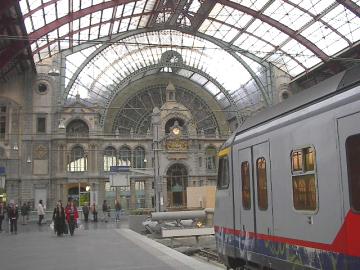 In fact, I was looking forward to meeting the InterNations Ambassadors from our Local Communities in the Belgian cities of Antwerp, Brussels, and Gent, as well as Eindhoven just across the Dutch border. We had agreed to have dinner together in Antwerp on Saturday night, and that’s why I found myself on a flight to Brussels and then on a train bound to Antwerp.
In fact, I was looking forward to meeting the InterNations Ambassadors from our Local Communities in the Belgian cities of Antwerp, Brussels, and Gent, as well as Eindhoven just across the Dutch border. We had agreed to have dinner together in Antwerp on Saturday night, and that’s why I found myself on a flight to Brussels and then on a train bound to Antwerp.
At Brussels Airport, I felt rather proud of myself when I could make good use of my slightly rusty French skills from my high school days. However, since Antwerp belongs to Belgium’s Flemish community, I was a bit lost with the language there. I grew up in the west of Germany, fairly close to the Dutch border. But the kind of Dutch I used to know as a kid turned out to be quite different from Flemish, especially regarding pronunciation. Fortunately, as a tourist, you can safely stick to English!
I checked in at my hotel, which was not far from Antwerp’s impressive central station. 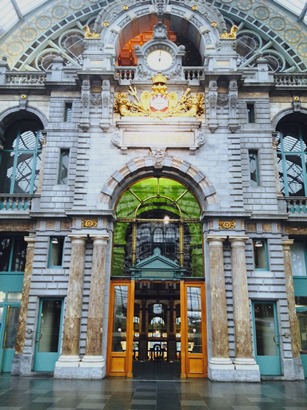 I’ve never given much thought to railway architecture, or thought that a train station, of all places, could be particularly pretty, but that was one of the most beautiful station buildings I’d ever seen. Antwerp’s historical center in general is highly picturesque, and I appreciated that it was within walking distance of the hotel. So was the famous Antwerp Zoo, but I couldn’t squeeze a visit into my busy schedule.
I’ve never given much thought to railway architecture, or thought that a train station, of all places, could be particularly pretty, but that was one of the most beautiful station buildings I’d ever seen. Antwerp’s historical center in general is highly picturesque, and I appreciated that it was within walking distance of the hotel. So was the famous Antwerp Zoo, but I couldn’t squeeze a visit into my busy schedule.
 I’ve never given much thought to railway architecture, or thought that a train station, of all places, could be particularly pretty, but that was one of the most beautiful station buildings I’d ever seen. Antwerp’s historical center in general is highly picturesque, and I appreciated that it was within walking distance of the hotel. So was the famous Antwerp Zoo, but I couldn’t squeeze a visit into my busy schedule.
I’ve never given much thought to railway architecture, or thought that a train station, of all places, could be particularly pretty, but that was one of the most beautiful station buildings I’d ever seen. Antwerp’s historical center in general is highly picturesque, and I appreciated that it was within walking distance of the hotel. So was the famous Antwerp Zoo, but I couldn’t squeeze a visit into my busy schedule.
Instead, I took a stroll through the historical part of town, past the Rubens House, to Grote Markt, the main square, with its monumental Renaissance city hall, a stunning Gothic cathedral, and the many guildhouses testifying to the wealth of Antwerp’s merchants and burghers. Of course, there are also plenty of cafés and bakeries selling delicious Belgian-style waffles. No visit would be complete without having a bite.
After my mid-morning snack, I briefly refreshed back at the hotel, and then I met Rachele and Caterina, the InterNations Antwerp Ambassadors, for coffee and Flemish appeltaart at a nearby shopping mall. Both of these friendly ladies gave up their native Italy for Belgium a while ago, and they are now taking good care of our expat community in Antwerp. We chatted about local life, sharing tips and tricks for developing the rapidly growing InterNations Community even further.
After our pleasant “coffee klatch”, I headed straight for the dinner venue in the southern part of town. The restaurant, Bizie Lizie, was a trendy brasserie in the best Belgian tradition, and I waited to welcome Praxedes and Joaquim from Gent for a little pre-dinner aperitif.

Praxedes, a Filipino-American lady, and Joaquim, a Spanish consultant from Catalonia’s capital, both settled in Gent around the same time, back in February 2013. They are very much interested in supporting other new arrivals and new members of our Local Community. Gent is one of the “rising stars” among our smaller communities, and we therefore discussed the next steps for community development.
While we were still talking, we were joined by InterNations Ambassadors Eric and Maria from our bustling, 22,000-member (!) community in Brussels. Later on, our little group was complete when Caterina and Rachele returned, and Anthonius arrived from Eindhoven in the Netherlands. Our party of eight even had a room of our own for a private dinner at Bizie Lizie.
The brasserie’s menu introduced me to such typical Flemish/Dutch starters as vleeskroket andkaaskroket, croquettes filled with meat ragout or cheese. Over local specialties – lots of savory dishes with meat, fish, and, of course, French fries – we exchanged feedback on InterNations and general thoughts on community life.

It was great to finally meet so many Ambassadors in person and to participate in such a lively exchange of ideas! I’ve already assembled a “to do” list for my own work, my team, and others at the InterNations office. My head was nearly buzzing with so much input and so many impressions when I got back to my hotel for the night.
On the following morning, I was up bright and (relatively) early to have breakfast with Anthonius, part of our Ambassador team in the dynamic city of Eindhoven. Just like Gent, Eindhoven belongs to our “rising stars” in Europe, and we talked a lot about best practice tips for moving forward with a changing community. After breakfast, Anthonius kindly offered me a ride to the station, so I could catch my train back to Brussels and my plane to Munich.
 All in all, I really enjoyed the opportunity to touch base with so many Ambassadors at once. For your energy and effort, as well as for your warm welcome to Belgium, a heart-felt “thank you”,“danke schön”, “merci” and“dank u wel”!
All in all, I really enjoyed the opportunity to touch base with so many Ambassadors at once. For your energy and effort, as well as for your warm welcome to Belgium, a heart-felt “thank you”,“danke schön”, “merci” and“dank u wel”!
I also had a lovely first impression of Antwerp, a city I really recommend for a weekend trip or mini-break. I’d have loved to stay longer and would like to be back some day. The diamonds will just have to wait until next time!
(Image credit: 1) Public Domain 2)-5) Amelie Dinges/InterNations)
Founder’s Diary: Chisinau & Vilnius
The first InterNations Community visits in 2014 took me to Eastern Europe last month – or, to be more precise, to Chisinau (Moldova) and Vilnius (Lithuania), where we’ve got two of our smaller Local Communities. The one in Vilnius has already grown to 1,600 members by now while there are only 600 InterNations members in Moldova’s capital so far.
This time, I traveled together with some team members from our IT department in Munich: We are very much interested in adding to our IT capacity and finding more software engineers to work on our site, especially since the InterNations member base keeps growing and growing. The ICT sector in several Eastern European cities has a very good reputation, and Vilnius and Chisinau are among the prime examples.
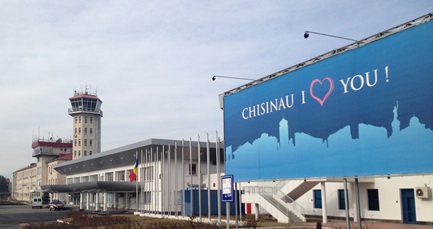 However, in other respects, the two capital cities proved to be rather different. The two-hour flight from Munich to Chisinau did not only take us to a different time zone, but also to one of the poorest countries in Europe. Since its independence from Soviet Russia in 1991, Moldova has been through some politically uncertain times.
However, in other respects, the two capital cities proved to be rather different. The two-hour flight from Munich to Chisinau did not only take us to a different time zone, but also to one of the poorest countries in Europe. Since its independence from Soviet Russia in 1991, Moldova has been through some politically uncertain times.
Roughly speaking, the country’s political scene seems to be torn between the champions of Communism and a strong pro-European faction. Although EU membership is now officially one of Moldova’s priorities, parts of Chisinau appeared to be almost stuck in its Soviet past.
Unfortunately, the city hasn’t yet had the time and resources to refurbish some run-down neighborhoods or to focus more on tourist attractions. When we asked a few residents about local sights we shouldn’t miss out on, the first disheartening reply was: “Nothing to see.”
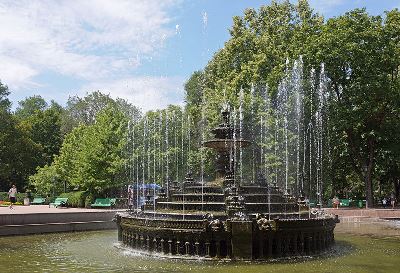 However, there are plenty of parks throughout Chisinau, and our guides also recommended the verdant countryside, as well as a tour through Moldova’s many wine-growing regions. It’s a pity we didn’t have time for a detour – and that we were there in January, rather than spring or summer.
However, there are plenty of parks throughout Chisinau, and our guides also recommended the verdant countryside, as well as a tour through Moldova’s many wine-growing regions. It’s a pity we didn’t have time for a detour – and that we were there in January, rather than spring or summer.
Our hotel in the city center (the Art Rustic) was definitely a great play to stay, though – a boutique hotel with very individualist décor and a personal touch. We then had lunch at a Gagauzian restaurant, where we got to meet a few prospective IT candidates. (The Gagauz minority are a Turkish-Bulgarian group spread over the Balkans, Eastern Europe, and Central Asia.)
In the evening, we tried out the Taifas restaurant, which had been recommended to us as a Moldovan-style place: folkloric decorations, traditional music, heavy food (mainly meat dishes with rich sauces), and a selection of local wines. That tour of Moldovan vineyards would really have been worth it!
On the following day, I met up with our Chisinau Ambassador Al from Iceland at the London Steakhouse in town (they sure do love their meat here!). He is a veritable globe-trotter with a colorful resume.
Al graduated from university in the UK, travelled through Africa, used to work in international finance and has lived in Egypt, Hong Kong, Japan, Spain, Switzerland, and Ukraine before. He moved to Moldova about a year ago, and we had an animated conversation about his expat experience so far. Al seemed really ambitious to organize events and bring the international community in Chisinau together.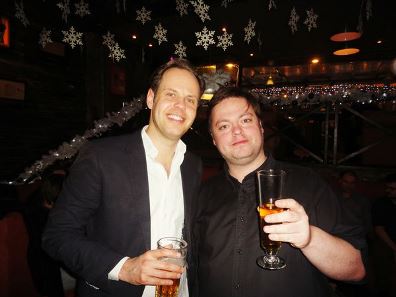

Our InterNations Event started later on the same day, at around 6:30 pm at Jack Daniels Bar. About 50 people were in attendance, including the IT guys we’d met earlier and invited to join us – not bad for such a comparatively small community!
We sat down for a nice dinner of grilled dishes (Chisinau must be a rather inconvenient place for vegetarians…), followed by mingling and chatting. Within a few hours, I got to know various interesting members, for example expats from the Netherlands, Turkey, and the US, as well as a few fellow Germans. Later on, the tunes of a live band lured most guests to the dance floor.
The die-hard partygoers then invited us to explore one of Chisinau’s top nightclubs: Drive turned out to be a very vibrant and dynamic venue, with a gleaming and stylish interior, and a lively crowd. For night owls travelling through Eastern Europe, this would be a “must see” recommendation.
Slightly fatigued, we had to return to Munich the following morning. We were leaving Moldova with the distinct impression that there may not be that many sights in Chisinau, but that the country is rich in resources nonetheless – its friendly people not least among them.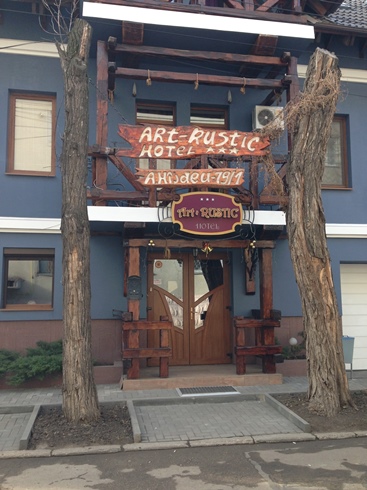

Barely one week later, I was on the road again, on my way to Lithuania. Again, I was accompanied by several other team members, since we were still on the lookout for talented software engineers and had scheduled a number of interviews in Vilnius. I’d actually been there before, to attend one of our early InterNations Events back in 2011, and I was excited to see the city once more.
However, I wasn’t quite prepared for the Baltic weather during a cold front in the middle of January: When we arrived, outdoor temperatures were nearly minus 20°C! Fortunately, the sun was shining, providing us with at least a little warmth – though our software developer from Brazil begged to disagree, poor guy.
However, the city was very pretty to look at under the winter sun, the roofs covered with a light dusting of snow. The historic center of Vilnius is a UNESCO World Heritage site for good reason – it unites an impressive array of Gothic, Renaissance, Baroque, and neoclassical architecture.
Our interviews with the IT company, however, took place in an ultra-modern building, a tall glass structure full of offices, which dominates the city’s skyline and gave us a splendid view of the Lithuanian capital. Again, we had some interesting talks with several software developers, who were eager to work on such an exciting project as InterNations.
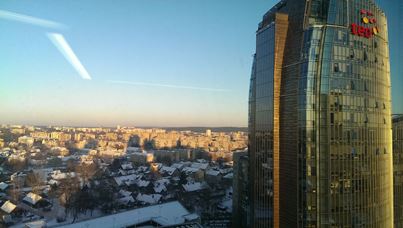 We were staying at the Comfort Hotel in Vilnius, and it did live up to its name: it was really comfy indeed. Moreover, it was only a short walk from the city center, so, with the freezing temperatures, we didn’t have to go far in search of a nice restaurant.
We were staying at the Comfort Hotel in Vilnius, and it did live up to its name: it was really comfy indeed. Moreover, it was only a short walk from the city center, so, with the freezing temperatures, we didn’t have to go far in search of a nice restaurant.
We had dinner close to the cathedral on Plines Street – a majestic building, which also happens to be the oldest church in Lithuania. At the restaurant, we were rather thankful for the hot and rich food. A steaming dish like zeppelini – Lithuanian dumplings with pork, bacon, and sour cream – is a good choice when it’s chilly outside!
On the following day, we invited the IT developers to our InterNations Event at the Holiday Inn. The hotel manager, Geerd from Belgium, is also an InterNations member and had kindly agreed to hosting our get-together there.
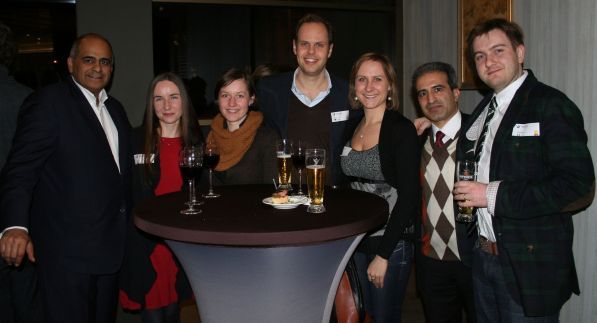 Of course, it was our Ambassador Team in Vilnius that organized the event: Anthony from France has spent plenty of time abroad, on various trips to Bangladesh, Germany, Indonesia, Norway, and Thailand. He moved to Lithuania over six years ago, for personal reasons, and is working in the local garment industry. Shaan was born in India, raised in the US, and now divides his time between Vilnius and London.
Of course, it was our Ambassador Team in Vilnius that organized the event: Anthony from France has spent plenty of time abroad, on various trips to Bangladesh, Germany, Indonesia, Norway, and Thailand. He moved to Lithuania over six years ago, for personal reasons, and is working in the local garment industry. Shaan was born in India, raised in the US, and now divides his time between Vilnius and London.
I was pretty impressed by their international credentials, and I could also thank our Ambassadors in person for their success at growing the InterNations Community and creating such a relaxed, familial atmosphere at their events. That night, circa 70 members from 20 different countries attended, which made for a bit of a contrast with our huge and kind of busy parties in Munich.
Quite a few of the guests are on the NATO staff or work for various EU organizations, as I found out while circulating and chatting. Meanwhile, our IT team seized the chance to gather some feedback on our online platform directly from our members, which resulted in a fruitful exchange of comments and ideas.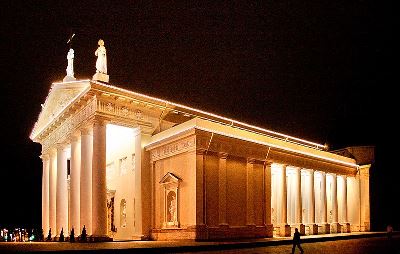

But we weren’t only “all work and no play”! When the official part of the event was winding down, some friendly Vilnius members took us to Pabo Latino, a Latin bar, where we danced the night away to some hot rhythms that defied the icy weather.
All in all, we liked the city a lot. And who knows? Perhaps we’ll soon have a reason to come to Vilnius more often…
(Image credit: 1, 4, 5: Malte Zeeck/InterNations 2: Chisinau Stefan cel Mare Park by Wikimedia Commons user Myrabella 3: Alina Lip 6: Anthony Poullain 7: Vilnius Cathedral at Night by Wikimedia Commons user Juliux)
A Place to Switch On All Your Senses
Our guest author Ben uses his new home Hong Kong as a springboard to delve into the beauties of another Asian country…
You get to a new place, and you are so focused on your new job and settling in that you sometimes forget one of the best things about being an expat: the ability to explore a new region of the world. So it’s good to remind yourself every now and then that your new home is a great springboard to jump off to small excursions. One of Hong Kong’s many advantages is being a transit hub and an ideal base for discovering East and Southeast Asia.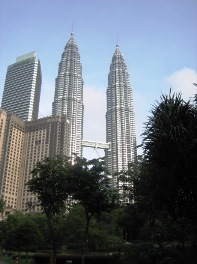
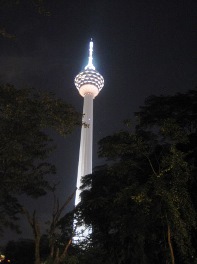


How did journalist Pico Iyer once describe traveling? “Traveling is a little bit like falling in love, because suddenly all your senses are switched on.” Recently, I took a couple of days off to visit Malaysia — and wow, what a way to switch on my senses.
As soon as I stepped off the plane, the heat and humidity were like a punch in the face. As I was walking down the steps into the terminal, I could feel the sun’s rays roasting my skin. Hong Kong is hot and humid, too, but Malaysia takes it to a whole new level.
Despite the heat, Kuala Lumpur is a great place to start exploring Southeast Asia because there are cheap flights to about, well, everywhere. KL is also a modern cosmopolitan city, which is well-organized, easy to get around, and has loads of fun things to do. You can find yourself in the middle of sparkling glass skyscrapers in the morning; wandering through a tropical rain forest in the afternoon; dining on a pristine beach while listening to the sea’s enchanting symphony in the evening.
 Malaysia is where Malay, Chinese, and Indian cultures have intersected for hundreds of years, but also where the Portuguese, Dutch, and English each tried to exert their influence at various times. The mixture is evident in Malaysia’s languages, religions, and architecture. Just walk down a street in any Malaysian city, and you will find colorful Hindu temples, grand Muslim mosques, and smoke-filled Buddhist temples, as well as classic European churches.
Malaysia is where Malay, Chinese, and Indian cultures have intersected for hundreds of years, but also where the Portuguese, Dutch, and English each tried to exert their influence at various times. The mixture is evident in Malaysia’s languages, religions, and architecture. Just walk down a street in any Malaysian city, and you will find colorful Hindu temples, grand Muslim mosques, and smoke-filled Buddhist temples, as well as classic European churches.
But where the diversity really shines is in the food. With such a rich history and mix of cultures, you can find authentic cuisine from all over Asia or discover some of their fusion cousins. I suggest roaming Malaysia’s numerous night markets because that’s where the locals go to eat and you’ll be able to try the best dishes.
I remember strolling through a dark quiet alley, and all of a sudden, the street opened up into a lively market that seemed to materialize out of thin air. It was full of bright lights, people scrambling everywhere, mouth-watering food sizzling on the grill, 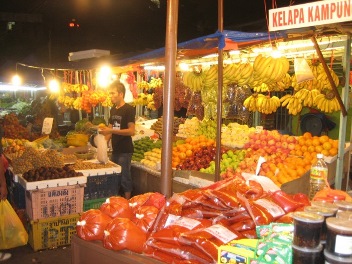 vibrant flashes of color, and hawker stalls offering various goods as far as the eye could see.
vibrant flashes of color, and hawker stalls offering various goods as far as the eye could see.
 vibrant flashes of color, and hawker stalls offering various goods as far as the eye could see.
vibrant flashes of color, and hawker stalls offering various goods as far as the eye could see.
One of the first carts I encountered served freshly made Roti Canai, and it was by far the best I ever ate. It was warm and soft and had the perfect combination of stickiness and flakiness. It was so tasty I had to order another one. I tried a sticky rice dumpling flavored with a blue flower that can only be found in Malaysia. I ate fresh seafood prepared in a Malay-Portuguese style with a subtle Chinese influence. I also sampled some interesting Baba-Nyonya dishes, which is a fusion of Malay and Chinese cooking.
Malaysia’s fascinating history, incredible vistas and, of course, the delicious food made this trip wonderful. But what truly made this journey unforgettable were the friendly and hospitable Malaysian people. They are so happy to help you find your way, recommend some scrumptious local delicacies, or simply strike up a conversation with you on the bus or at a food stall. I still remember each conversation I had with the people I’ve met, their kind demeanor, and warm smiles.
For me, Malaysia was the perfect place to awaken my vagabond spirit. I am already planning my next trip there, which is a good indicator of how much I loved it. I hope that in 2014, you will also have a chance to travel and switch on all your senses.
(Photo credit: Benjamin W.)

No comments:
Post a Comment